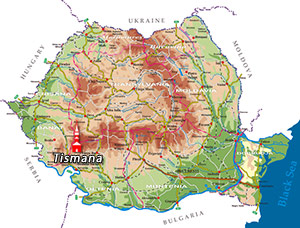
Considered byOltenia”, Tismana Monastery, together with its medieval walls and angular bulwarks, lies on the Starmina Mountain being surrounded by forests and steep crags, 30 km away from Targu Jiu. As a matter of fact, the Geta-Dacian toponym “tismena” meant “fortress” in its ancient times. During the archaeological works done in 1970, the foundation of a sanctuary was discovered nearly 4 m to the North of the lateral apse of the principal church. The sanctuary was built of river boulders and bricks and dated from the time of the Roman occupation over the land. This discovery led the archaeologists to the conclusion that an old Dacian-Roman fort had existed in this area.
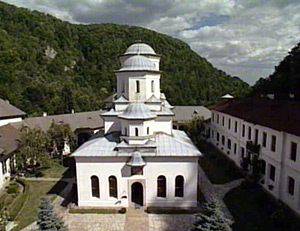
The one who started the building of the monastery was Nicodim, The Pious, a monk that came here from Macedonian lands, with the help of the ruler Radu Negru-Voda. Thus, on the 15th August 1377, the church was sanctified, on The Assumption of the Holy Virgin dedication day. After Radu Negru-Voda’s death, the building of the monastery continued under the rule of his successors, Dan I Basarab (1384-1386) and Mircea cel Batran(1387-1418).
Placed strategically and being protected by fortification walls, Tismana Monastery was built on an important spot at the borders of Wallachia, a reason for which the inhabitants of the village with the same name had to defend the monastery, a task that spared them from tributes and quitrents. No wonder that the Revolution in 1821 led by Tudor Vladimirescu bursted after the release of the Pades Proclamation at 22nd January 1821, document which demanded the Phanariots’ banishment and the stopping of the plunders and injustices.
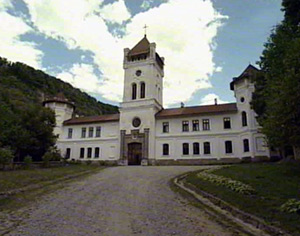
The importance of the spot is also given by the fact that a lot of documents were kept here dating the 14th century and that fact contributed to the formation of the basis of a true historiography. Because of its riches and administration manner, many bans settled their residences there, the oldest being theBan of Tismana who settled there in 1464.
A school of educated monks was also established there at Tismana Monastery, some of those monks being later selected in order for them to become bishops and metropolitans, clerks for handwriting and translation.The monks that left this monastery founded later monasteries in Ardeal, Moldavia and Wallachia.
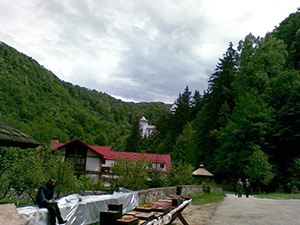
About the monastery
Because it’s placed in full natural frame, one may find its entrance through its West side and thank to its fortificated walls, Tismana Monastery gives the viewer the impression that it can’t be conquered.
In the beginning, the church was painted only in one colour, in ochre, presenting figures and flowers. The first icon was painted by the painter Dobromir from Targoviste in 1564, icon that is considered the first Byzantine painting from Wallachia.
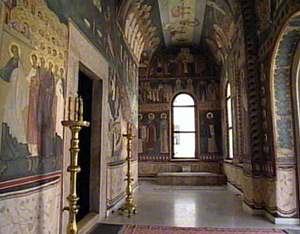
In 1732, the painting was restored and in 1766 Dimitrie Diaconu painted a fresco that was eventually placed in the pronaos of the church. The fresco was then taken out in 1955 under G. Rusu’s leadership and incorporated to the museum of the monastery.
The hallway was rebuilt in 1983, according to Nicodim, the Pious’ plans, and repainted by Grigore Popescu. With this occasion, all known and canonized Dacian-Roman saints were painted as well.
In 1949, Tismana Monastery became anuns community, nuns that even now keep the tradition of working for the monastery and praying daily.
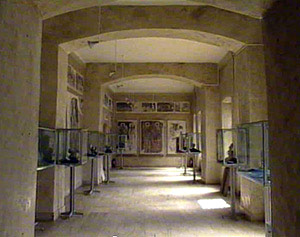
The hoard of the monastery
Many of the hoard items of Tismana Monastery have been lost along the history, but some of them may be found at the Romanian Art Museum. In the museum of the monastery, one can see a collection of mural paintings, icons painted on wood, various cult items, old clothing and the doors made in 1782. Three parts of relics are kept in the church: Saint Nicodim’s forefinger together with his lead cross he used to wear at his neck; a part of Saint Ignatie’s body and a part of Saint Ioan Gura de Aur’s body as well. The iconostasis was made of oak wood in 1766, but in 1844 it was gilded and adorned with majestic icons. The chandelabrum is made of glazed brass and the metal plate which calls people to church has the shape of a two-headed eagle (Basarab rulers’ symbol).
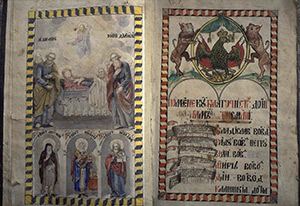
There are also two icons painted on glass, which were donated by the poet George Cosbuc in 1916, in memory of his son, Alexandru.
In 1944, the hoard of the Romanian National Bank was hidden at Tismana Monastery, so that the Russian Army could get its hands on it. At first, this hoard was kept in one of the cellars of the monastery, but then it was moved for safety in the cave of the monastery. On the whole, almost 380 tons of gold ingots and 3 tons of gold items belonging to the Polish hoard were deposited.
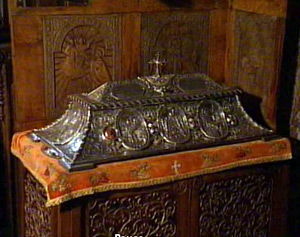
Nicodim, the Pious
Nicodim, the Pious, the one who started the building of the monastic sanctuary, was supposed to be related to Basarab rulers and to the Prince Lazar of Serbia.
It is said that when he was 16 years old he left his native home(the fortified city Prilep from Macedonia) and arrived to Hilandru Monastery, at the Athos Mountain, where he managed to learn Slavonic, Greek and how to write calligraphically, how to paint, to silver. He also learned the architecture, the masonery, the cooperage and many other occupations.
Before arriving at Tismana, Nicodim also had founded the following monasteries: Vratna, Manastirita (in Serbia), Vodita, Gura Motrului, Topolnita, Visina, Aninoasa (in Wallachia) and Prislop (in Hateg).
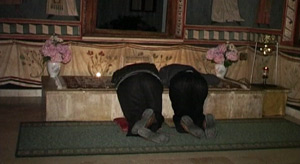
Nicodim was the one who brought at Tismana a group of monks, the first place for praying being the cave situated in the big rock near the monastery.
In the following years he founded here the famous school for hand writing, where many transcribers were hired in order for them to transcribe religious bools in various languages. Even a version of the four gospels, overlaid with gilded silver covers, was written calligraphically by Nicodim himself – this book is considered the oldest book in Wallachia. At the moment, this work may be found at the National History Museum in Bucharest. In 1375, Nicodim, the Pious was given the noble title of archimandrite, title given by Filotei, the Patriarch of Costantinopol, and Tismana Monastery became the first archimandry in Wallachia.
At 26th December 1406, Nicodim died and was buried in the hallway of the church, where even today a candle burns in his memory. He was canonized by the Romanian Orthodox Church in 1955.
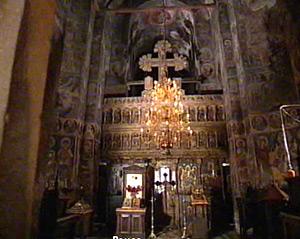
Another heritages in the area
In the North-West side of Tismana Monastery, there are two more heritages which lie on the Cioclovina Mountain. If one takes a walk through mountain paths, one may discover 5 km away the heritage Cioclovina de Jos, founded sometime in 1660, its celebration day being “Sfintii Voievozi”. 3 km farther, the heritage Cioclovina de Sus may be spotted (dedication day-The Transfiguration). The church at Cioclovina de Sus was sanctified in 2005 by Teofan, who was at that time the Archibishop of Craiova and the Metropolitan of Oltenia. At the moment, Teofan is the Metropolitan of Moldavia and Bucovina.
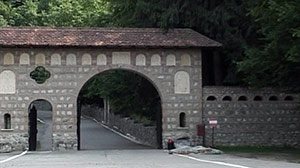
How to get there
If one wants to get to Tismana Monastery, one should follow the road 67D after exiting Targu Jiu. On the way, there are the village Pestisani and the forest Dumbrava to pass through.Once this is done, the monastery is at full sight.
Another way to arrive to Tismana is by following the road DN67 from Drobeta Turnu Severin till the location Apa Neagra (Black Water) and afterwards taking the road 67 D to Tismana.
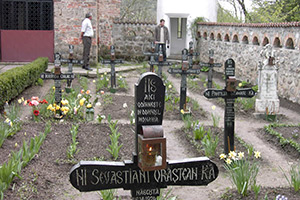
In the area there are also another places that are worth visiting, such as Podul lui Dumnezeu (God’s bridge), Pestera Ponoarelor (Ponoare Cave), Bulba Gorges, Bulba Cave and the natural reservation of wild lilac (syring vulgaris). Further more, from Apa Neagra ( Black Water), one may get to Pades and see Tudor Vladimirescu’s monument. Following this route, Sohodol Gorges, Sohodol Cave and some other caves can be spotted (Muierii Cave,Toplita Cave and many more).
Between Targu Jiu and Tismana, Susitei Gorges, Runcului Gorges and Vai Waterfall can be visited. In the locality Borosteni, there is an archaological station together with human settlements dating the Middle Palaeolithic and Neolithic periods.

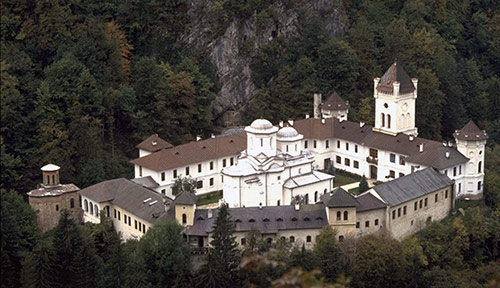
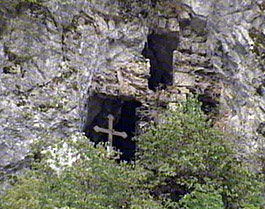
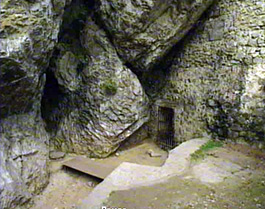
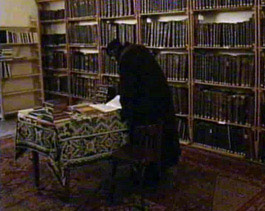
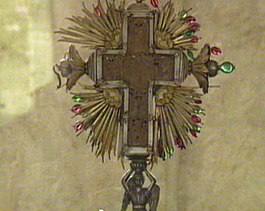
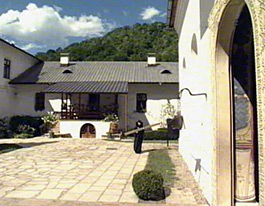
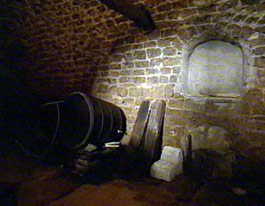
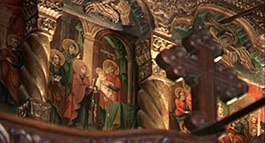
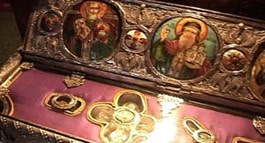
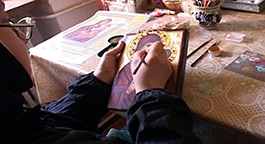
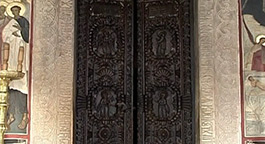
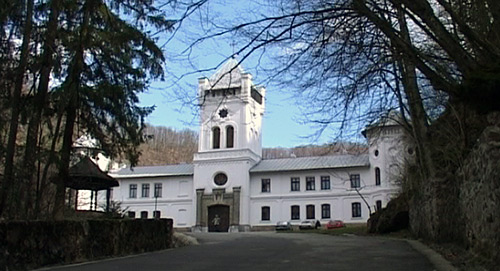
Niciun comentariu:
Trimiteți un comentariu